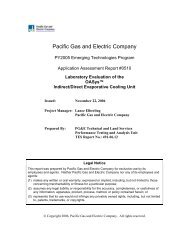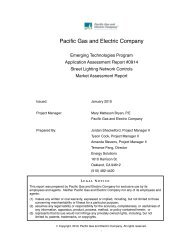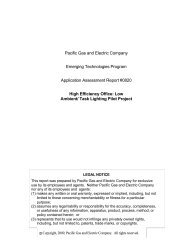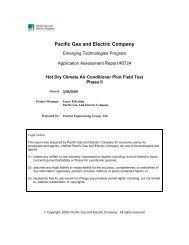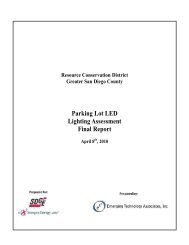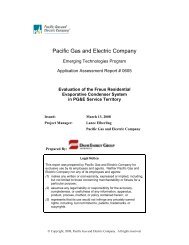PGE Wireless Pneumatic Thermostat ET Final Report.pdf
PGE Wireless Pneumatic Thermostat ET Final Report.pdf
PGE Wireless Pneumatic Thermostat ET Final Report.pdf
You also want an ePaper? Increase the reach of your titles
YUMPU automatically turns print PDFs into web optimized ePapers that Google loves.
PG&E’s Emerging Technologies Program <strong>ET</strong>11<strong>PGE</strong>3171<br />
Table 1: Pilot Site Parameters<br />
Pilot Site Project Initiation Vendor Location Building Type Size (sq ft)<br />
1 <strong>ET</strong>AP Manufacturer 1 East Bay Office (w courts) 100,000<br />
2 Oakland Shines Manufacturer 1 East Bay Office 200,000<br />
3 Vendor Manufacturer 1 Peninsula Office 144,000<br />
4<br />
SMUD Smart Grid<br />
Investment<br />
ENERGY EFFICIENCY MEASURE EVALUATION<br />
We identified the following groups of energy efficiency measures, which we used in our<br />
evaluation of each site. Energy saving measures which can be enabled with WPT systems<br />
can be grouped into 7 types. These types are listed briefly in the table below.<br />
Table 2: EEMs Potentially Enabled by Installation of WPT Systems<br />
SCHEDULING/S<strong>ET</strong>BACKS<br />
Manufacturer 2 Central Valley Classrooms (w Office) 60,000<br />
EEM Short Name Description<br />
1 Scheduling/Setbacks<br />
Creating programmable setbacks by zone with<br />
occupancy override capability<br />
2 SAT Reset<br />
Supply air temperature (SAT) reset based on zone<br />
operating conditions<br />
3 DSP Reset<br />
Duct static pressure (DSP) reset based on zone<br />
demand<br />
4 Deadband<br />
Separate cooling and heating temperature<br />
setpoints with deadband between them.<br />
5 Setpoint Enforcement Centralized control of the limits of user control<br />
6 GTA (incl Pre-Cooling)<br />
7 RCx<br />
Global temperature adjustment (GTA): Altering<br />
zone setpoints throughout the day<br />
Retrocommissioning / Troubleshooting: Using data<br />
to identify problems<br />
When spaces are not occupied continuously, the HVAC systems serving those spaces should<br />
be scheduled to maintain conditions only during occupied hours. At the zone level, this often<br />
means implementing temperature setbacks so the temperature setpoint range of a space is<br />
greatly increased during unoccupied hours (e.g. 55-85°F unoccupied vs. 68-74°F occupied).<br />
A standard pneumatic thermostat normally has only one temperature setpoint. The setpoint<br />
is fixed and can only be changed at the thermostat itself by either an occupant or building<br />
staff person.<br />
12



